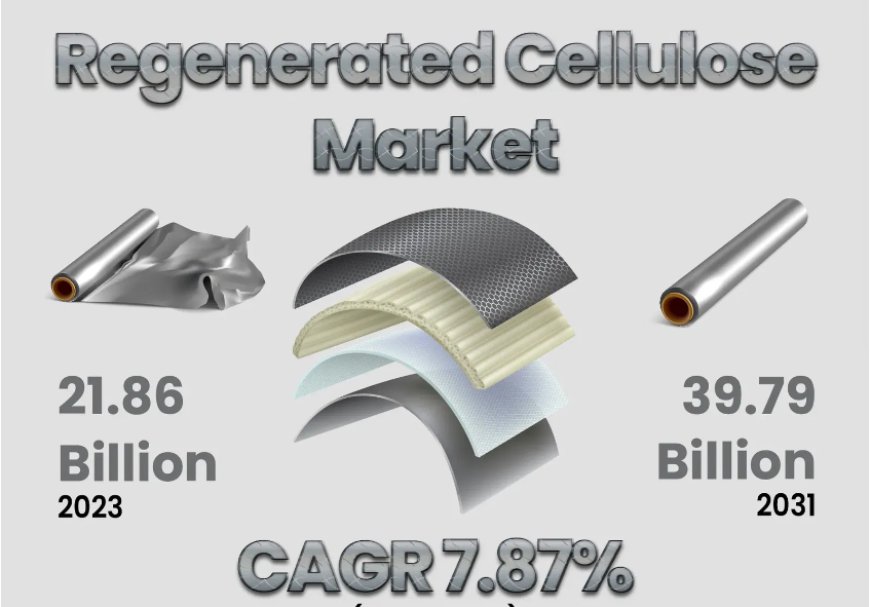Regenerated Cellulose Market Projected to Experience a Growth Rate of 7.87% CAGR, Reaching over USD 19.84 Billion by 2031 | Milliken & Company, LENZING AG, Sateri
Regenerated Cellulose Market Revenue, Insights, Overview, Outlook, Analysis

Regenerated Cellulose Market size was valued at USD 21.86 billion in 2023 and is projected to reach USD 39.79 billion by 2031, growing at a CAGR of 7.87% from 2024 to 2031. The global market is experiencing significant growth, mainly fueled by the burgeoning demand for sustainable fashion.
The textile industry remains one of the largest consumers of regenerated cellulose. This market is primarily fueled by the demand for viscose, rayon, and lyocell, which are all derived from regenerated cellulose. These fibers have gained significant popularity because they offer the softness and breathability of natural fibers like cotton, while also providing superior moisture-wicking and durability features. The growing awareness among consumers regarding eco-friendly fabrics has fueled the demand for regenerated cellulose fibers. Sustainable fashion has emerged as a significant trend, particularly among millennials and Gen Z consumers, who are increasingly seeking brands that prioritize environmental responsibility. As a result, major fashion houses and retail brands have started incorporating regenerated cellulose-based fabrics into their product lines, leading to steady market growth.
The packaging industry also represents a key driver of the regenerated cellulose market. With growing pressure to reduce plastic waste, companies are turning to biodegradable alternatives to meet consumer demands for more sustainable packaging solutions. Regenerated cellulose films offer several benefits, including high transparency, strength, and moisture barrier properties, making them ideal for food packaging. These films also have excellent gas permeability, making them suitable for fresh produce packaging. Additionally, the renewable and compostable nature of regenerated cellulose packaging aligns with global sustainability goals, pushing manufacturers to adopt this material in their packaging processes. As more consumers become aware of the environmental impacts of single-use plastics, the demand for sustainable packaging materials is likely to surge, further driving growth in the regenerated cellulose market.
Browse Full Report Details @ https://www.kingsresearch.com/regenerated-cellulose-market-593
List of Key Companies in Regenerated Cellulose Market
- Ahlstrom-Munksjö
- Asahi Kasei Corporation
- Domtar Corporation
- Milliken & Company
- LENZING AG
- Sateri
- Birla Cellulose
- Win-Win Textiles
- Domo Chemicals
- Kelheim Fibres GmbH
In terms of regional analysis, the Asia-Pacific region holds the largest share of the regenerated cellulose market, with China and India being the primary contributors. The region’s dominance can be attributed to the presence of a large textile industry, a growing population, and increasing disposable incomes, which are driving the demand for both clothing and hygiene products. Additionally, government initiatives promoting sustainable practices and the development of eco-friendly materials are expected to further bolster market growth in this region. For instance, China’s growing focus on green textiles and its commitment to reducing carbon emissions have created a favorable environment for the expansion of regenerated cellulose production facilities. India, too, is witnessing a rise in demand for sustainable textiles, driven by both the growing export market and domestic consumption.
North America and Europe are also important markets for regenerated cellulose, particularly due to the increasing demand for sustainable fashion and packaging solutions. Both regions have seen a rise in consumer awareness regarding the harmful effects of plastic waste and the benefits of biodegradable materials. In Europe, stringent regulations aimed at reducing single-use plastics and encouraging the adoption of sustainable materials have created a favorable environment for the regenerated cellulose market. Countries such as Germany, the United Kingdom, and France have introduced various legislative measures to curb plastic pollution, including bans on certain plastic products and mandates on recycling. These policies have led to an increase in the adoption of biodegradable materials, including regenerated cellulose, in packaging and textiles.
Major apparel brands are now incorporating regenerated cellulose fibers into their collections, catering to the growing demand for sustainable fashion. Additionally, companies in the packaging industry are investing in research and development to create innovative cellulose-based packaging solutions that can replace traditional plastic materials. The U.S. government has also introduced various initiatives aimed at reducing the environmental impact of packaging, which is likely to further drive the market for regenerated cellulose.
Technological advancements are playing a crucial role in the growth of the regenerated cellulose market. Innovations in manufacturing processes have made the production of regenerated cellulose more efficient and cost-effective. For example, the development of the lyocell process has made it possible to produce high-strength regenerated cellulose fibers with minimal environmental impact.
Regenerated Cellulose Market is Segmented as:
By Product Type
- Fiber
- Film
By Manufacturing Process
- Viscose
- Cuprammonium
- NMMO
- Acetate
By Source
- Wood-Pulp
- Non-Wood Pulp
- Recycled Pulp
Contact Us:
Kings Research
Website: https://www.kingsresearch.com
E-mail: business@kingsresearch.com
Phone: (+1) 888 328 2189
